

BH027165-HNCD-Art-and-Design-Units-Issue5. An Introduction to Holga Photography. The Holga is a camera, first manufactured in China in 1981, made almost entirely of plastic, some even have plastic lenses.
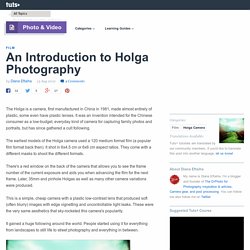
It was an invention intended for the Chinese consumer as a low-budget, everyday kind of camera for capturing family photos and portraits, but has since gathered a cult following. The earliest models of the Holga camera used a 120 medium format film (a popular film format back then). It shot in 6x4.5 cm or 6x6 cm aspect ratios. They come with a different masks to shoot the different formats. There's a red window on the back of the camera that allows you to see the frame number of the current exposure and aids you when advancing the film for the next frame. This is a simple, cheap camera with a plastic low-contrast lens that produced soft (often blurry) images with edge vignetting and uncontrollable light leaks. It gained a huge following around the world. Generally speaking, if the Holga model name includes an F (e.g. Penumbra Foundation. The Center for Alternative Photography (CAP) is the educational department of Penumbra Foundation which was developed in 2001.

CAP is dedicated to teaching historical, emulsion based and alternative photographic processes. Upcoming workshops are on a set scheduled throughout the semester. A minimum of 3 students is required for all workshops to run. Londonalternativephotography.wordpress.com. The Chicago School of Media Theory. “If thou gaze long into an abyss, the abyss will also gaze into thee” — Nietzsche, Beyond Good and Evil The range of meaning of the verb “to see” is so vast that a typical thesaurus contains a list of fifty-odd synonyms, among them “to look, glimpse, eye, notice, stare, etc.”
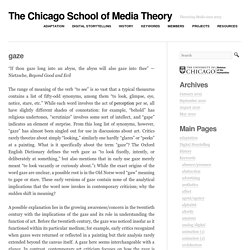
While each word involves the act of perception per se, all have slightly different shades of connotation: for example, “behold” has religious undertones, “scrutinize” involves some sort of intellect, and “gape” indicates an element of surprise. From this long list of synonyms, however, “gaze” has almost been singled out for use in discussions about art.
Critics rarely theorize about simply “looking,” similarly one hardly “glares” or “peeks” at a painting. What is it specifically about the term “gaze”? A possible explanation lies in the growing awareness/concern in the twentieth century with the implications of the gaze and its role in understanding the function of art. London Riots 1381: Blood-soaked Peasants' Revolt that changed England forever. By Professor John Gillingham Updated: 11:10 GMT, 30 September 2011 They make for a rag-tag army.

One of them is an elderly shepherd armed with nothing more deadly than his crook, another is a young boy who clings for protection to the drum with which he has bravely set the pace of their advance. Interview with Photographer Gregory Crewdson. Gregory Crewdson, an American artist renowned for his elaborately devised photographs of small-town life, digs into the commonplace and familiar to find images that are haunting, surreal and—most agree—profoundly unnerving.
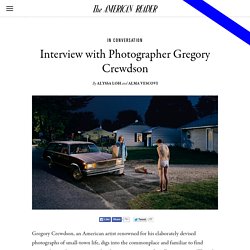
(Though Crewdson himself, we discovered, finds his work essentially “optimistic.”) With production teams and set budgets that rival those of entire films, Crewdson chronicles moments of disconnect—downcast eyes, faces turned away—in expansive portraits of people lost in thought, isolated and inaccessible, both to each other and to the viewer. His images are rich in detail, and there is not a thing in the frame—not a stain, not a lampshade—that he does not carefully select. And yet, this abundance of detail is balanced with a striking lack of information—the settings are ordinary (a suburban kitchen, a living room, a dark street corner)—and, more importantly, the frame is de-contextualized: we don’t know what happens before or after, or who these people even are.
A Primer In Effective Questioning Strategies For Classroom & eLearning - By Rosa Fattahi, WizIQ The Importance of Questioning in the Learning Process Since the ancient days of philosopher Socrates, asking questions has been a critical part of the teaching and learning process.

The well-known question-and-answer technique that Socrates employed with his pupils demonstrated how well dialogue and discourse work to stimulate students, encourage more complex thinking, and help them learn. For educators, verbal questioning also helps foster a sense of community in the classroom and keeps students engaged in the instructional process. Thus, in order to maintain active classroom dialogue and encourage student involvement, it is important for teachers to understand and employ effective questioning techniques. Questions are invaluable teaching tools that serve many functions in the teaching and learning processes. Ebrary: New Reader Overview. Www2.glos.ac.uk/offload/tli/lets/lathe/issue1/articles/brown.pdf. Rethinking Learning for a Digital Age: How Learners are Shaping their Own Experiences: Amazon.co.uk: Rhona Sharpe, Helen Beetham, Sara de Freitas: Books. Book Description Publication Date: 16 July 2010 | ISBN-10: 0415875439 | ISBN-13: 978-0415875431 Rethinking Learning for a Digital Age addresses the complex and diverse experiences of learners in a world embedded with digital technologies.

The text combines first-hand accounts from learners with extensive research and analysis, including a developmental model for effective e-learning, and a wide range of strategies that digitally-connected learners are using to fit learning into their lives. A companion to Rethinking Pedagogy for a Digital Age (2007), this book focuses on how learners’ experiences of learning are changing and raises important challenges to the educational status quo. Rethinking Learning for a Digital Age: Today’s learners are active participants in their learning experiences and are shaping their own educational environments. Frequently Bought Together Customers Who Bought This Item Also Bought. Rethinking Learning for a Digital Age How Learners are Shaping their own Experiences - Preview.
How To Use Bloom’s Taxonomy To Write Learning Outcomes. By: Scott Davis Business Analyst, Pearson It is often quite difficult to relate inputs to outcomes in the world of education.

Traditionally, much work has been done to develop and provide inputs into the process of education. These inputs, such as a textbook, an assessment, a learning technology or platform, a course, a qualification, a high-stakes test or professional development for teachers are put into the hands of an educational leader, a skillful teacher, or an eager student. The Super Book of Web Tools for Educators: FREE ebook!! How to Teach Without a Lecture and other fun. Two Great Blooms Taxonomy Posters for Teachers. Blooms Taxonomy is another topical theme I keep writing about here in Educational Technology and Mobile Learning whenever I stumble upon a new resource.
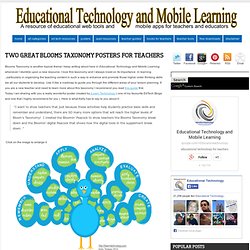
I love this taxonomy and I always insist on its importance in learning , particularly in organizing the teaching content in such a way to enhance and promote those higher order thinking skills we all our students to develop. Use it like a roadmap to guide you through the different areas of your lesson planning. If you are a new teacher and need to learn more about this taxonomy I recommend you read this guide first. Today I am sharing with you a really wonderful poster created by iLearn Technology ( one of my favourite EdTech Blogs and one that I highly recommend for you ). Here is what Kelly has to say to you about it : "I want to show teachers that just because these activities help students practice basic skills and remember and understand, there are SO many more options that will reach the higher levels of Bloom’s Taxonomy!
Educationalelearningresources.yolasite.com/resources/guildresearch_blooms2013 (1).pdf. Educationalelearningresources.yolasite.com/resources/guildresearch_blooms2013 (1).pdf. Reflections - Hiteching in El Salvador. Journal entry: 04/02/13 My personal definition of educational technology is definitely morphing and taking shape at this very moment.
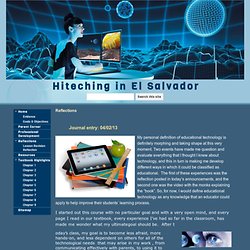
Two events have made me question and evaluate everything that I thought I knew about technology, and this in turn is making me develop different ways in which it could be classified as educational. The first of these experiences was the reflection posted in today’s announcements, and the second one was the video with the monks explaining the “book”. So, for now, I would define educational technology as any knowledge that an educator could apply to help improve their students’ learning process. I started out this course with no particular goal and with a very open mind, and every page I read in our textbook, every experience I’ve had so far in the classroom, has made me wonder what my ultimategoal should be. Www.unco.edu/cetl/sir/stating_outcome/documents/Krathwohl.pdf. Bloom's Taxonomy. Www.celt.iastate.edu/pdfs-docs/teaching/RevisedBloomsHandout.pdf.
21st Century Tools Through the Lens of Bloom’s Taxonomy. Over this past weekend, I attended the 1st Annual Wyoming TEC Conference. TEC stands for Technology in the Evolving Classroom. During this conference, I had the fortunate opportunity to sit in on Angie Spann‘s session on 21st Century Tools. Angie is a Librarian and Media Specialist at Sweetwater School District #1. Here is the session’s abstract, “Our students need several skills to help them learn and become productive in the 21st Century. This session will explore web 2.0 tools to help students learn/practice these skills that they will need. During the presentation, Angie introduced recommended technologies to use based on Bloom’s Taxonomy, or more correctly the digital Bloom’s Taxonomy.
Anita's List: Free Educational Resources for All: Bloom's (Revised) Taxonomy - Interative. This is not the type of post I normally do but Bloom's Taxonomy was such a huge help to me when I was teaching and developing educational products that I thought it was important and relevant. Bloom's Taxonomy is a structure to help explain the different levels of questioning. It has been revised recently and there have been many attempts to explain the revisions. This interactive diagram is one of the best explanations I have seen.
The diagram is set up so mousing over each square pops up an example of an activity that matches the level of questioning. In many cases teachers are asked to make sure classroom assessments cover all levels of Bloom's taxonomy and this diagram would be very helpful in doing that. Bloom’s Revised Taxonomy. ILA Overview (information-learning theories and model) The ILA allowed students to learn about Australian Colonisation following a guided inquiry approach. The goal of the unit was to allow students to formulate a deep understanding of the subject area by way of research. This style of research has many benefits as highlighted by Kuhlthau (2007). This includes competency when researching, a motivation to learn, language development and social skills. Students were presented with the inquiry question- ‘What was life like as a convict?’ Assessment References › Assessment Primer › Assessment › University of Connecticut.
Allen, Mary J., Assessing Academic Programs in Higher Education, Anker Publishing Company, Inc., 2004 Allen, Mary J., Assessing General Education Programs, Anker Publishing Company, Inc., 2006 Anderson, Lorin W. and Krathwohl, David R. (Eds.) with Airasian, Peter W., Cruikshank, Kathleen A., Mayer, Richard E., Pintrich, Paul R., Raths, James, and Wittrock, Merlin C., A Taxonomy for Learning, Teaching, and Assessing: A Revision of Bloom’s Taxonomy of Educational Objectives, Addison Wesley Longman, Inc. 2001.
Bain, Ken, What the Best College Teachers Do, Harvard University Press, 2004 Banta, Trudy W., Lund, Jon P., Black, Karen E. and Oblander, Frances W., Assessment in Practice: putting principles to work on college campuses by Jossey-Bass, 1996 Banta, Trudy W. and Associates (editors), Building a Scholarship of Assessment, Jossey-Bass, John Wiley & Sons, 2002. Assessment References › Assessment Primer › Assessment › University of Connecticut. Www.sacscoc.org/institute/2014/2014SIHANDOUTS/Monday/Cleary2Mon.pdf. Blooms elluminate.pdf. Bloom's Digital Taxonomy. Www.srhe.ac.uk/conference2012/abstracts/0228.pdf.
Are students the consumers of higher education? Live chat best bits. Melonie Fullick, PhD researcher in education, York University, Canada Think of education as a process not a product: The more tuition students pay, the more they want to 'get something out of' their education. And who can blame them? Normally when one pays a high price for something, that transaction builds expectation.
So we have to ask whether a metaphor of consumerism is giving people a helpful idea of what to expect from their educational experience and I don't think it is. Students engage in the process of education; they themselves contribute significantly to its 'outcomes'; they share responsibility for what they 'get' at the end of it. Enter into partnership with students: Universities must talk to students about tuition fees and why these are so much higher than they used to be.
Www.principals.in/uploads/pdf/CurriculumDesignPlanning/Designinglearning.pdf. Teaching Today: A Practical Guide - Geoffrey Petty. Www.oecd.org/edu/imhe/QT policies and practices.pdf. Promoting lifelong professional development in geographical education. Promoting lifelong professional development in geographical education. Coventry University - Login. The Scholarship of Teaching: New Elaborations, New Developments. The Scholarship of Teaching: New Elaborations, New Developments It's the middle of June as we begin this article, and our writing faces serious competition from the spirited company of 43 faculty in residence here at The Carnegie Foundation.
Members of the Carnegie Academy for the Scholarship of Teaching and Learning (CASTL), these "Carnegie Scholars"selected through the Pew National Fellowship Program, one of CASTL's components—examine teaching and learning issues in their fields in order, as our program materials say, to 1) foster significant, long-lasting learning for all students, 2) advance the practice and profession of teaching, and 3) bring to teaching the recognition afforded to other forms of scholarly work. One Scholar is studying "moments of difficulty" as opportunities for student learning; another is pilot-testing a new model for teaching accounting; several have focused their work on ways to make students more purposeful, self-directed learners. Www.theknowledgepartnership.com/uk/wp-content/uploads/2012/01/University-League-Tables-The-Impact-on-Student-Recruitment.pdf. 11-944-higher-education-students-at-heart-of-system.pdf. 10-1208-securing-sustainable-higher-education-browne-report.pdf.
COP_AOS.pdf. Www.gees.ac.uk/planet/p17/lp.pdf. Peer Observation A5 -final.pdf. Digitalcommons.unl.edu/cgi/viewcontent.cgi?article=1249&context=podimproveacad. Www.cumbria.ac.uk/Public/Education/Documents/Research/ESCalateDocuments/TheUseOfTeachingObservationInHE.pdf. Ucu_lessonobsproject_nov13.pdf. The Scholarship of Teaching. Indiana University Research & Creative Activity April 1999 Volume XXII Number 1 by Eileen Bender and Donald Gray Our work as university professors for a long time has been bedeviled by two injurious ideas.
The first is that the demands of teaching and research are counterforces fiercely contending for control of our time. The very metaphors we use to characterize the plight of professors reflect this idea. We are acrobats, juggling unevenly weighted "teaching loads" and programs of research; or, worse, we are scholars and scientists held hostage in classrooms, for whom ransoms must be negotiated to gain "release" for research. The second idea is that we are curiously alone in our classrooms. We tend to assume that what we do in our classrooms is so individual and private that it cannot be evaluated or even fruitfully talked about. Teaching & Learning Inquiry: The ISSOTL Journal, Vol. 1, No. 1 (2013), pp. 121-125.
Formats Available in JSTOR: Article PDF For the Scholarship of Teaching and Learning (SoTL) to be understood as significant intellectual work in the academy, SoTL practitioners need to identify shared principles of good practice. While honoring the diversity of SoTL in its many forms across the globe, such principles can serve as a heuristic for assessing work in our field. These principles include (1) inquiry into student learning, (2) grounded in context, (3) methodologically sound, (4) conducted in partnership with students, and (5) appropriately public.
Reconceptualising Feedback in Higher Education: Developing dialogue with students: Amazon.co.uk: Stephen Merry, Margaret Price, David Carless, Maddalena Taras: Books. Reconceptualising Feedback in Higher Education: Developing dialogue with. ProQuestRefWorks. 2.5 Managing Folders in RefWorks. Degrees of digitization - digital technology and the contemporary university. Enhancing Feedback. Educational Leadership:Multiple Measures:Feed Up, Back, Forward. Like the sailors in Samuel Coleridge's poem "The Rime of the Ancient Mariner" who see "water, water everywhere, nor any drop to drink," teachers often feel awash in a resource that is of little help. Teachers have more assessment data about individual students at their fingertips than we could have imagined a decade ago. What is Rigorous Instruction? - IgnitED. This year was our first year implementing the Common Core Standards and a reoccurring word that is used when describing the standards is they are more rigorous than the previous state standards.
Educational Technology and Mobile Learning: blooms taxonomy. Overcoming Barriers to Student Understanding: Threshold Concepts and Troublesome Knowledge: Amazon.co.uk: Jan Meyer, Ray Land: Books. Threshold Concepts within the Disciplines: Amazon.co.uk: Ray Land, Jan Meyer, Jan Smith: Books. Give (and Get) Some Good Advice. Welcome! - eduClipper. Analysis of online quizzes as a teaching and assessment tool. Optional Online Quizzes: College Student Use and Relationship to Achievement. Analysis of online quizzes as a teaching and assessment tool.
The Threshold Concept.
Analysis of online quizzes as a teaching and assessment tool. Optional Online Quizzes: College Student Use and Relationship to Achievement. Analysis of online quizzes as a teaching and assessment tool. Www.uq.edu.au/economics/abstract/494.pdf. Www.jite.org/documents/Vol12/JITEv12IIPp129-146Wong FT116.pdf. Www.bk.psu.edu/Documents/IT/Hillman_TLI_report.pdf. Www.open.ac.uk/about/teaching-and-learning/esteem/files/esteem-pa/file/ecms/web-content/rita-tingle.pdf. Analysis of online quizzes as a teaching and assessment tool. Files.eric.ed.gov/fulltext/ED505824.pdf. Create, Engage, Assess through Mobile Devices.